Dangerous Levels of EMFs
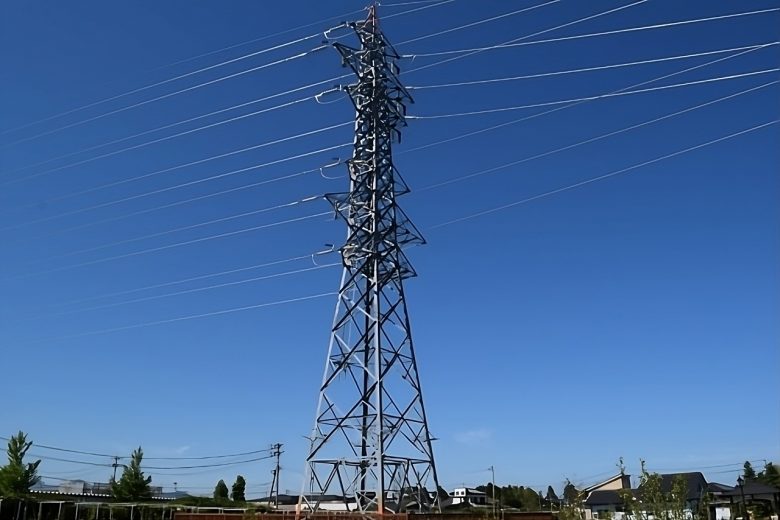
We will explore the dangerous levels of strength at which EMFs can affect health, based on the studies we have seen.
We then compare that with the strength of the EMFs around us.
First, a brief description of the properties of EMFs is given, explaining that the magnetic field component of EMFs is dangerous.
I will also tell you why the results of studies on EMFs are inconsistent.
Table of ContentsAll_Pages
Properties of EMFs
The space in which electrical forces work is called an electric field, and the space in which magnetic forces work is called a magnetic field.
When an electric current flows, a magnetic field is generated in the surrounding area. If the strength or direction of the current changes at this time, the strength and direction of the magnetic field also change. This change in the magnetic field generates a new electric field. The changing electric field further generates a magnetic field. Fields (or waves) that propagate through space while the magnetic and electric fields repeatedly generate each other in this way are called electromagnetic fields (EMFs).
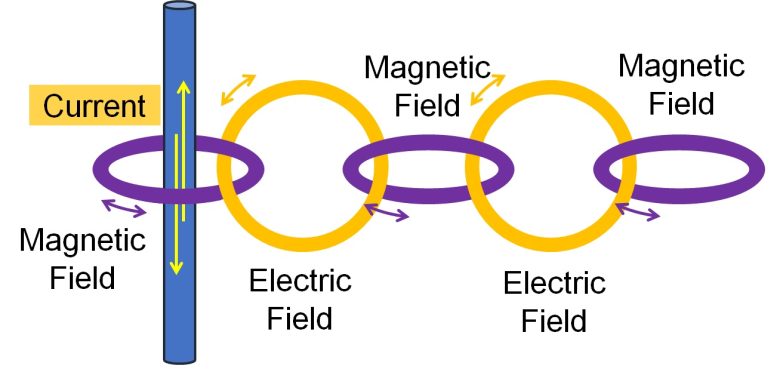
EMFs, both natural and man-made, are very wide-ranging, from extremely low-frequency EMFs of below 300 Hz emitted by electrical appliances, to microwaves of 300 MHz or higher used by cell phones, to light of 3 THz or higher, to ionizing radiation of 3000 THz or higher.
The properties of EMFs vary with frequency.
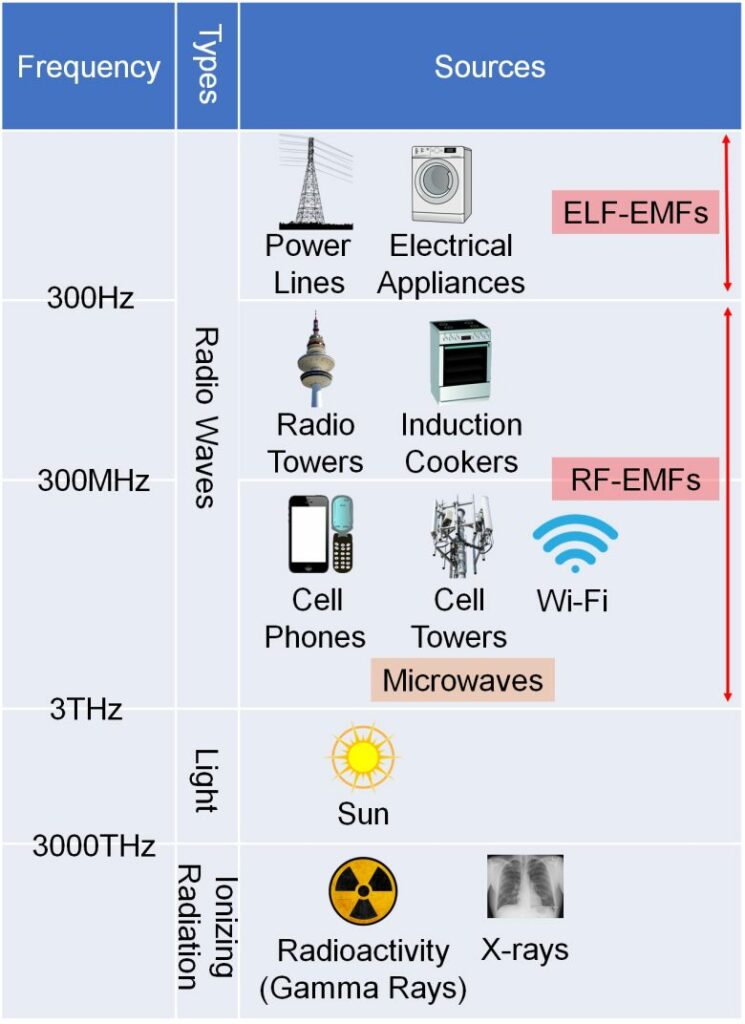
In this site, I refer to extremely low-frequency EMFs of below 300 Hz emitted by power lines and electrical appliances as ELF-EMFs, and radio-frequency EMFs used by radio towers, cell phones, and cell towers as RF-EMFs.
ELF-EMFs have very long wavelengths (about 6,000 km at 50 Hz) and have lost most of their wave-like properties, with the electric and magnetic fields existing independently.
Magnetic Field Component is Dangerous
And among ELF-EMFs, magnetic fields have been shown to have strong biological effects.
For example, an experiment in which human colon cancer cells were exposed to extremely low-frequency electric or magnetic fields, or both, showed that colony formation of cancer cells increased in response to the magnetic field component to a large extent. (Phillips et al. 1986)
Colony formation of cancer cells increased 1.7-fold with electric fields, 14-fold with magnetic fields, and 24-fold with electric and magnetic fields.
Also, the classification by the International Agency for Research on Cancer (IARC) also states that extremely low-frequency magnetic fields and radio-frequency electromagnetic fields, where magnetic and electric fields are combined and inseparable, are "possibly carcinogenic," while extremely low-frequency electric fields are "not classifiable as to its carcinogenicity".
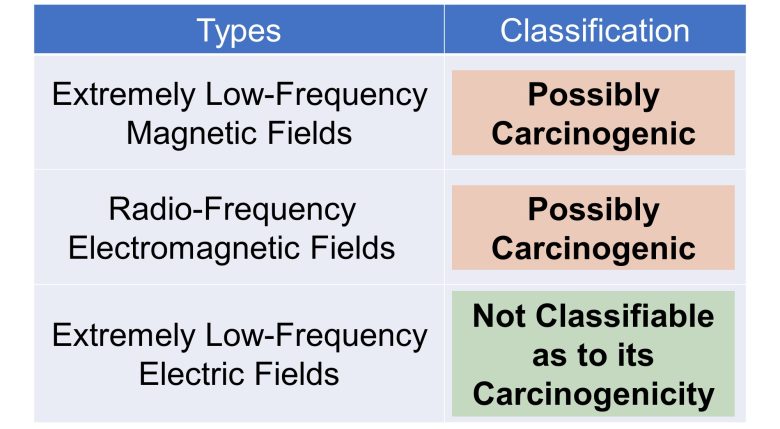
This may have something to do with the fact that ELF magnetic fields easily penetrate the human body, whereas the effects of ELF electric fields are limited to the body surface.
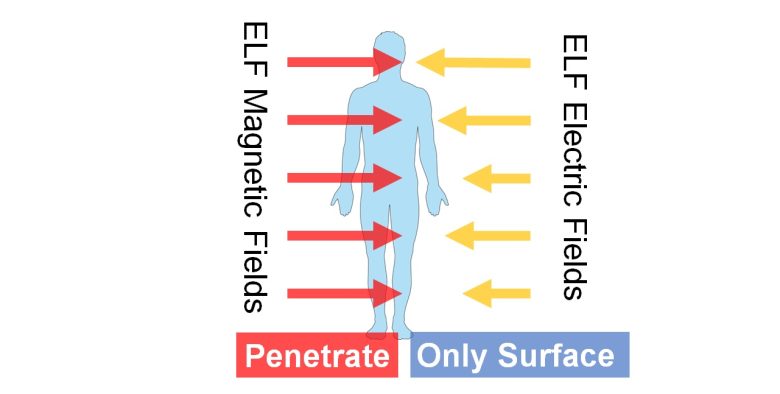
As for the principle of how EMFs affect health, the prevailing hypothesis is that when irradiated with EMFs, magnetic chemical compounds (*) in living organisms absorb the energy depending on the magnetic field component of the EMFs (magnetic resonance), and alter the yield of reactants, such as reactive oxygen species. (Hore and Mouritsen 2016, Ritz et al. 2009, Vácha et al. 2009, Müller and Ahmad 2011, Sherrard et al. 2018, Barnes and Greenebaum 2014, Thöni et al. 2021)
So, although still hypothetical, the magnetic field component of EMFs is, even in principle, dangerous.
The current leading candidate is a protein called cryptochrome. Cryptochromes temporarily form magnetically sensitive "radical pairs" in their chemical reactions, which could alter the yield of reactants depending on EMFs.
Cryptochromes function as a biological clock (clock gene) in mammals. Since the use of clock gene have been observed in cells throughout the body in mammals (Mohawk et al. 2012), it follows that if EMFs interfere with cryptochrome chemical reactions, their influence extends throughout the body.
Dangerous Levels of ELF-EMFs
High-Voltage Lines and Electrical Appliances
Magnetic Fux Density
Magnetic flux density is commonly used as a measure of the strength of ELF-EMFs from high-voltage lines and electrical appliances.
It represents the strength of the magnetic field in space and is measured in μT.
Dangerous Level
The studies we have seen so far indicate that the dangerous level is 0.1 µT or higher.
Danger level of ELF-EMFs
A value of 0.1 μT or higher, or to be on the safe side, 0.01 μT or higher, can be taken as the dangerous level.
High-Voltage Lines
Meanwhile, the strength of ELF-EMFs emitted by a high-voltage line is as follows. (The Electric Power Research Institute)
Strength of ELF-EMFs
from a High-Voltage Line
The strength of ELF-EMFs exceeds 10 μT within 16 yards (15 m) of a high-voltage line, and 1 μT past 66 yards (60 m).
This means that ELF-EMFs from high-voltage lines are more than 100 times higher than 0.1 μT of the dangerous level.
Electrical Appliances
Next, the strength of ELF-EMFs emitted by electrical appliances is as follows. (Gauger 1985, Aerts et al. 2017, Florig and Hoburg, Institute of Electrical and Electronics Engineers, The Electric Power Research Institute, Tell and Kavet 2016, Japan EMF Information Center)
Strength of ELF-EMFs
from Electrical Appliances
The strength of ELF-EMFs exceeds 1 μT in many electrical appliances. (Maximum value)
As for the Induction cookers, the strength of the magnetic field is in the mid-frequency range of 300 Hz to 1 MHz.
This means that the ELF-EMFs from electrical appliances are more than 10 times higher than 0.1 μT of the dangerous level.
Dangerous Levels of RF-EMFs
Cell Towers and Radio Towers
Power Density
Power density is often used as a measure of the strength of RF-EMFs from radio towers and cell towers.
It represents the amount of EMF energy in space and is measured in μW/cm2.
Dangerous Level
The studies we have seen so far indicate that the dangerous level is 0.001 μW/cm2 or higher. But the number of studies is not sufficient.
Dangerous Level of RF-EMFs
A value of 0.001 μW/cm2 or higher can be taken as the dangerous level.
It is calculated from the strength of the electric field described in the paper, as the impedance of free space 377 Ω.
Cell Towers
Meanwhile, the strength of RF-EMFs from a cell tower is as follows. (Marinescu and Poparlan 2016)
Strength of RF-EMFs
from a Cell Tower
The strength of RF-EMFs exceeds 0.1 μW/cm2 within 220 yards (200 m) of a cell tower, and 0.01 μW/cm2 past 440 yards (400 m).
Radio Towers
Next, the strength of RF-EMFs from a radio tower is as follows. (Al-Ruwais 2001)
Strength of RF-EMFs
from a Radio Tower
The strength of RF-EMFs exceeds 0.1 μW/cm2 even at 1090 yards (1000 m) from a radio tower.
This means that RF-EMFs from cell towers and radio towers are more than 100 times higher than 0.001 μW/cm2 of the dangerous level.
Cell Phones
Specific Absorption Rate (SAR)
Specific absorption rate (SAR) is used as a measure of the strengh of RF-EMFs from cell phones.
it represents the amount of EMF energy absorbed by the body and is measured in W/kg.
SAR is an averaged value of EMF absorption in a certain area of the body.
Whole-Body Average SAR
It is an averaged value of EMF absorption over the whole body.
Local SAR
It is an averaged value of EMF absorption over any 1g or 10g of tissue.
The SAR of cell phones is the largest local SAR in the head, i.e., the area that absorbs EMFs the most, the local SAR at the surface of the head.
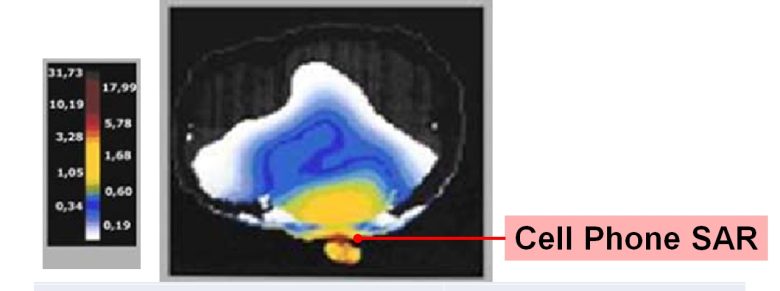
Distribution of SAR in the head
( Cited and modified from Gandhi et al. 1996 )
Dangerous Level (Local SAR)
The studies we have seen so far indicate that the dangerous level is 0.1 μW/kg or higher. But all are limited to animal experiments.
Dangerous Level of
Local SAR
A value of local SAR of 0.1 W/kg or higher can be taken as the dangerous level.
Cell Phones
Meanwhile, the published local SAR values of recently launched cell phones are as follows.
Strength of EMFs
from Cell Phones
The strength of EMFs exceeds the local SAR of 0.1 W/kg for any products.
This means that any current model cell phones exceeds the local SAR of 0.1 W/kg of the dangerous level.
Dangerous Level (Whole-Body Aberage SAR)
Several studies have obtained whole-body average SARs in rats and mice.
The studies we have seen so far indicate that the dangerous level is 0.0001 W/kg or higher. But the number of studies is not sufficient.
Dangerous Level of
Whole-Body Average SAR
A value of whole-body average SAR of 0.0001 W/kg or higher can be taken as the dangerous level.
Culture-medium average SAR
The local SAR of a cell phone is the value at the surface of the head where EMFs are absorbed the most.
Therefore, on the surface of the head, EMFs from cell phones are more than 1000 times higher than 0.0001 W/kg of the dangerous level.
In parts at a certain distance from a cell phone, their SARs are unknown, so comparisons cannot be made.
However, even if the SAR were attenuated to 1/1000 of its maximum value, it would still be enough energy to affect health, and various parts of the human body would be damaged.
Why are the Study Results Inconsistent ?
So far we have seen numerous studies showing that EMFs have various effects on health.
On the other hand, however, there are at the same time numerous studies showing no effects.
One reason for the inconsistency in the study results is conflicts of interest.
A conflict of interest is a set of conditions in which professional judgment concerning a primary interest (such as a patient's welfare or the validity of research) tends to be unduly influenced by a secondary interest (such as financial gain). (Thompson 1993)
In the past, studies on the health effects of tobacco showed inconsistent results due to conflicts of interest.
So, it can be said that the same thing is happening in research on EMFs.
Dr. Becker's Writings
Dr. Becker was twice nominated for the Nobel Prize and was a pioneering researcher in the field of biological electricity and regeneration.
He led the opposition to EMFs from high-voltage lines and other sources in the early days.
In his book, The Body Electric, he describes how the military and industry put their own interests first, ignored the dangers of EMFs, and tried to crush research and scientists who showed it.
The Body Electric
However, the safety standard had already become a Procrustean bed (an arbitrary standard to which exact conformity is forced) against which all research proposals and findings were measured. Grants weren't given to look for low-level hazards, and scientists who did find such effects were cut down to size. Funds for their work were quickly shut off and vicious personal attacks undermined their reputations. Later, when undeniable biological changes began to be noted from power densities between 1,000 and 10,000 microwatts, the idea of "differential heating"—— hot spots in especially absorptive or poorly cooled tissues—— was advanced, as though this convenient explanation obviated all danger. Soviet research could easily be discounted because of its "crudity," but when nonthermal dangers were documented in America, military and industrial spokespeople simply refused to acknowledge them, lying to Congress and the public. Many scientists, who naturally wanted to continue working, went along with the charade.
The pattern was exactly the same as the one regarding fallout dangers from nuclear weapons tests. (p306-307)
Our survival depends on the ability of upright scientists and other people of goodwill to break the military-industrial death grip on our policy-making institutions. (p329)
In the past, these character flaws couldn't wholly prevent the recognition of scientific truths. Both sides of a controversy would fight with equal vehemence, and the one with better evidence would usually win sooner or later. In the last four decades, however, changes in the structure of scientific institutions have produced a situation so heavily weighted in favor of the establishment that it impedes progress in health care and prevents truly new ideas from getting a fair hearing in almost all circumstances. (p332)
Finally, we must add to these factors the buying of science by the military. To call it a form of prostitution is an insult to the oldest profession. Nearly two thirds of the $47-billion 1948 federal research budget went for military work, and in the field of bioelectricity the proportion was even higher. While military sponsors often allow more technical innovation than others, their employees must keep their mouths shut about environmental hazards and other moral issues that link science to the broader concerns of civilization. In the long run, even the growth of pure knowledge (if there is such a thing) can't flourish behind this chain link fence. (p333)
The lab ceased to exist on New Year's Day 1981. The local VA chief had the gall to offer Andy and Joe jobs as night administrative officers. Instead, Marino went to work at Louisiana State University Medical School in Shreveport, where he still investigates the positive silver technique on a small scale. Spadaro also remained in orthopedic surgery, at the SUNY Upsate Medical Center right there in Syracuse. Maria Reichmanis decided she'd had enough of professional science, quit research entirely, and got married. This was the end of the foremost group working toward limb and spinal cord regeneration and one of the few bioelectromagnetism labs outside the DOD-industry orbit.
I've taken the trouble to recount my experience in detail for two reasons. Obviously, I want to tell people about it because it makes me furious. More important, I want the general public to know that science isn't run the way they read about it in the newspapers and magazines. I want lay people to understand that they cannot automatically accept scientists' pronoucements at face value, for too often they're self-serving and misleading. I want our citizens, nonscientists as well as investigators, to work to change the way research is administered. The way it's currently funded and evaluated, we're learning more and more about less and less, and science is becoming our enemy instead of our friend. (p347)
Dr. Davis's Lecture
Dr. Davis is an American epidemiologist and also the founder and president of Environmental Health Trust (EHT), a think tank that promotes a healthier environment through research, education, and policy.
EHT has won a court case against the Federal Communications Commission (FCC) over safety limits for human exposure to wireless radiation. (Environmental Health Trust)
EHT Wins Court Challenge!
The court held that the FCC failed to respond to “record evidence that exposure to RF radiation at levels below the Commission’s current limits may cause negative health effects unrelated to cancer.” Further, the agency demonstrated “a complete failure to respond to comments concerning environmental harm caused by RF radiation.” The court found the FCC ignored numerous organizations, scientists and medical doctors who called on them to update limits and the court found the FCC failed to address these issues:
• impacts of long term wireless exposure
• impacts to children,
• the testimony of people injured by wireless radiation,
• impacts to wildlife and the environment
• impacts to the developing brain and reproduction.
In her lecture at the University of Melbourne, Australia, Dr. Davis also spoke about the inconsistency of research results due to conflicts of interest.
Lecture at the University of Melbourne in 2015
(47 min 25 sec - 48 min 40 sec)
There are many inconsistent results. I'm not just skimming the cream here showing you the positive ones. There are a lot of studies that find nothing at all, nothing. Why?
Well, First of all, sometimes they study different cell cultures. So, if you're looking for adult cells, they may be much more robust than if you're looking at neuronal stem cells, and that turned out to be the case. Sometimes they're using different exposures if you're looking at a contenuous wave versus digital pulse signals, if you're looking at a square wave versus a sign wave.
There's also another fact we have to talk about which is yet another reason why I'm glad that Austrailia is not America.
Sponsored research, this is to put it politely, can induce publication bias (studies with negative results are less likely to be published). Another way to say this is that where you stand on an issue depnds on where you sit and who's bought your chair.
And there's a tremendous amount of soponsored research by people who are hired to do studies to find no effect.
And that's plagued this field in a number of countries, including within the government itself, including within the government itself.
(14 min 50 sec - 15 min 30 sec)
Now way back in the dark ages when the standards were developed, two dimensional modeling showed that children and smaller adults might absorb more radiation than larger adults.
And this was scalar modeling that has now been superseded, done by Om Gandhi in 1996.
Interestingly, and this is why I'm really delighted to be here Dean, when he did this work in 1996 he was working with support from Motorola and the Department of Defence.
And after he published this, he lost all his funding.
Similarities with the Tobacco Industry
The inconsistencies in research findings on the health effects of EMFs have similarities to those of the tobacco industry in the past.
The following 2012 paper describes conflicts of interest "invented" by the tobacco industry.
Inventing Conflicts of Interest: A History of Tobacco Industry Tactics
Confronted by compelling peer-reviewed scientific evidence of the harms of smoking, the tobacco industry, beginning in the 1950s, used sophisticated public relations approaches to undermine and distort the emerging science.
The industry campaign worked to create a scientific controversy through a program that depended on the creation of industry–academic conflicts of interest. This strategy of producing scientific uncertainty undercut public health efforts and regulatory interventions designed to reduce the harms of smoking.
A number of industries have subsequently followed this approach to disrupting normative science. Claims of scientific uncertainty and lack of proof also lead to the assertion of individual responsibility for industrially produced health risks.

